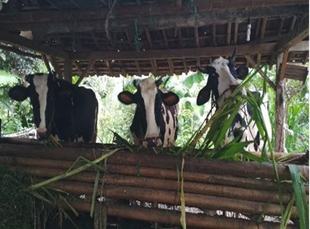Handling of endometritis in dairy cow after infection with foot and mouth disease and abortion

Downloads
This study aims to report the handling of endometritis in a dairy cow at Koperasi Agro Niaga Jabung, Malang, Indonesia. A Holstein Friesian cross heifer was diagnosed at 258 days pregnant and clinically suffering from Foot and Mouth Disease. On the 266th day of pregnancy, the fetus died, an abortion was diagnosed, and the delivery was assisted by the veterinarian. Furthermore, the cow was treated with 15 mL oxytetracycline intramuscularly. The next day, the veterinarian treated the retained placenta. On the third day after the abortion, the farmer reported that the cow had vaginal discharge which was cloudy white, reddish and smelled bad. The veterinarian treated the cow with an injection of 15 mL of Oxytetracycline. On the sixth day after the abortion, the farmer reported that vaginal discharge still coming out again. Clinical symptoms were, thick, purulent, cloudy, pink discharge from the vagina that hanged in the vulva area and smelled bad. Physical examination showed a body temperature of 40°C, and rectal palpation revealed the uterine wall to be thick, hard, stiff, and getting warmer. Furthermore, the cow was given intrauterine flushing with 1% povidone-iodine (diluted in distilled water), followed by intrauterine administration of 15 mL Oxytetracycline, analgesics, antipyretics, and antispasmodics. Fifteen mL of vitamin B12, ATP, and minerals (Magnesium, Potassium, Sodium selenite) was injected intramuscularly.
Appiah MO, Wang J, Lu W. 2020. Microflora in the reproductive tract of cattle: A review. Agriculture 10: 232.
Buczinski S, Morin MP, Roy JP, Rousseau M, Villettaz-Robichaud M, Dubuc J. 2022. Use of ATP luminometry to assess the cleanliness of equipment used to collect and feed colostrum on dairy farms. J Dairy Sci. 105: 1638-48.
Chastant S, Saint-Dizier M. 2019. Inflammation: friend or foe of bovine reproduction? Anim Reprod. 16: 539-47.
de Lima FS. 2020. Recent advances and future directions for uterine diseases diagnosis, pathogenesis, and management in dairy cows. Anim Reprod. 17: e20200063.
Espadamala A, Pereira R, Pallarés P, Lago A, Silva-Del-Río N. 2018. Metritis diagnosis and treatment practices in 45 dairy farms in California. J Dairy Sci. 101: 9608-16.
Gonzalez-Rivas PA, Chambers M, Liu J. 2021. A pilot study comparing the pharmacokinetics of injectable cyanocobalamin and hydroxocobalamin associated with a trace mineral injection in cattle. J Vet Pharmacol Ther. 44: 406-10.
Imani Rastabi H, Guraninejad S, Naddaf H, Hasani A. 2018. Comparison of the application of lidocaine, lidocaine-dexamethasone and lidocaine-epinephrine for caudal epidural anesthesia in cows. Iran J Vet Res. 19: 172-7.
Islam MH, Sarder MJU, Rahman M, Kader MA, Islam MA. 2012. Incidence of retained placenta in relation with breed, age, parity and body condition score of dairy cows. Int J Nat Sci. 2: 15-20.
Ismail I, Indarjulianto S, Yusuf S, Purba FY. 2023. Clinical examination of foot and mouth disease of dairy cows in Sukamurni, Cilawu, Garut, West Java, Indonesia. IOP Conf. Series: Earth and Environmental Science 1174: 1-6.
Kötter T, da Costa BR, Fässler M, Blozik E, Linde K, Jüni P, Reichenbach S, Scherer M. 2015. Metamizole-associated adverse events: a systematic review and meta-analysis. PLoS One. 10: e0122918.
Lee SC, Jeong JK, Choi IS, Kang HG, Jung YH, Park SB, Kim IH. 2018. Cytological endometritis in dairy cows: diagnostic threshold, risk factors, and impact on reproductive performance. J Vet Sci. 19: 301-8.
Leutert C, von Krueger X, Plöntzke J, Heuwieser W. 2012. Evaluation of vaginoscopy for the diagnosis of clinical endometritis in dairy cows. J Dairy Sci. 95: 206-12.
Li Y, Wen H, Yang Y, Zhao Z, Gao H, Li H, Huang M. 2022. Potential prognostic markers of retained placenta in dairy cows identified by plasma metabolomics coupled with clinical laboratory indicators. Vet Q. 42: 199-212.
Liu J, Li L, Chen X, Lu Y, Wang D. 2019. Effects of heat stress on body temperature, milk production, and reproduction in dairy cows: a novel idea for monitoring and evaluation of heat stress - A review. Asian-Australas J Anim Sci. 32: 1332-9.
Mamas MA, Riady G, Daud R. 2018. Terapi endometritis menggunakan Oksitetrasiklin pada sapi Aceh yang didiagnosa dengan alat metricheck. J Ilmiah Mahasiswa Veteriner 2: 221-9.
Mido S, Murata N, Rawy MS, Kitahara G, Osawa T. 2016. Effects of intrauterine infusion of povidone-iodine on endometrial cytology and bacteriology in dairy cows with clinical endometritis. J Vet Med Sci. 78: 551-6.
Mileva R, Karadaev M, Fasulkov I, Petkova T, Rusenova N, Vasilev N, Milanova A. 2020. Oxytetracycline pharmacokinetics after intramuscular administration in cows with clinical metritis associated with Trueperella pyogenes infection. Antibiotics 9: 392.
Negasee KA. 2020. Clinical metritis and endometritis in dairy catlle: A review. Vet Med Open J. 5: 51-6.
Okawa H, Fujikura A, Wijayagunawardane MMP, Vos PLAM, Taniguchi M, Takagi M. 2017. Effect of diagnosis and treatment of clinical endometritis based on vaginal discharge score grading system in postpartum Holstein cows. J Vet Med Sci. 79: 1545-51.
Osawa T. 2021. Predisposing factors, diagnostic and therapeutic aspects of persistent endometritis in postpartum cows. J Reprod Dev. 67: 291-9.
Passoni MT, Krebs Ribeiro DC, França de Almeida SC, Furtado da Costa B, Grechi N, Lima Tolouei SE, Curi TZ, Degraf Cavallin M, Romano RM, Romano MA, Spercoski KM, Carvalho Dos Santos A, Carvalho Souza RI, Dalsenter PR, Martino-Andrade AJ. 2022. The analgesic Dipyrone affects pregnancy outcomes and endocrine-sensitive endpoints in female and male offspring rats. Toxicol Sci. 187: 80-92.
Ranjan R, Biswal JK, Subramaniam S, Singh KP, Stenfeldt C, Rodriguez LL, Pattnaik B, Arzt J. 2016. Foot-and-mouth disease virus-associated abortion and vertical transmission following acute infection in cattle under natural conditions. PLoS One. 11: e0167163.
Rouse CE, Eckert LO, Muñoz FM, Stringer JSA, Kochhar S, Bartlett L, Sanicas M, Dudley DJ, Harper DM, Bittaye M, Meller L, Jehan F, Maltezou HC, Å ubelj M, Bardaji A, Kachikis A, Beigi R, Gravett MG. 2019. Global alignment of immunization safety in pregnancy (GAIA) postpartum endometritis, infection following incomplete or complete abortion work group. Postpartum endometritis and infection following incomplete or complete abortion: Case definition & guidelines for data collection, analysis, and presentation of maternal immunization safety data. Vaccine 37: 7585-95.
Sheldon IM, Cronin JG, Bromfield JJ. 2019. Tolerance and innate immunity shape the development of postpartum uterine disease and the impact of endometritis in dairy cattle. Annu Rev Anim Biosci. 7: 361-84.
Sicsic R, Goshen T, Dutta R, Kedem-Vaanunu N, Kaplan-Shabtai V, Pasternak Z, Gottlieb Y, Shpigel NY, Raz T. 2018. Microbial communities and inflammatory response in the endometrium differ between normal and metritic dairy cows at 5-10 days post-partum. Vet Res. 49: 77.
Wagener K, Grunert T, Prunner I, Ehling-Schulz M, Drillich M. 2014. Dynamics of uterine infections with Escherichia coli, Streptococcus uberis and Trueperella pyogenes in post-partum dairy cows and their association with clinical endometritis. Vet J. 202: 527-32.
Yoshida R, Kitahara G, Osawa T. 2020. Intrauterine infusion of povidone-iodine: Its effect on the endometrium and subsequent fertility in postpartum dairy cows. J Vet Med Sci. 82: 926-34.
Zobel R. 2013. Endometritis in Simmental cows: Incidence, causes, and therapy options. Turk J Vet Anim Sci. 37: 134-40.
Copyright (c) 2023 Amalia Nadila Faradillah, Galuh Chandra Agustina

This work is licensed under a Creative Commons Attribution-ShareAlike 4.0 International License.
Ovozoa by Unair is licensed under a Creative Commons Attribution-ShareAlike 4.0 International License.
1. The journal allows the author to hold the copyright of the article without restrictions.
2. The journal allows the author(s) to retain publishing rights without restrictions
3. The legal formal aspect of journal publication accessibility refers to Creative Commons Attribution Share-Alike (CC BY-SA).
4. The Creative Commons Attribution Share-Alike (CC BY-SA) license allows re-distribution and re-use of a licensed work on the conditions that the creator is appropriately credited and that any derivative work is made available under "the same, similar or a compatible license”. Other than the conditions mentioned above, the editorial board is not responsible for copyright violation.




































